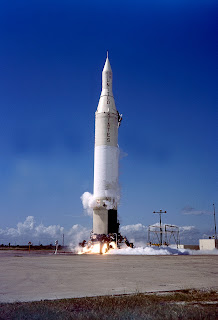SATURN-V for Dummies Part-1: The History of Saturn-V
The History of Saturn-V: Or how did Saturn-V come into being?
Saturn-V’s
ancestry can be traced back to the glorious V2 rocket. The German V2 rocket; developed by legendary Wernher von Braun, was meant to be used as a warhead
able to deploy payload (explosives) over a very large distance, it was the world’s
first long-range missile and was virtually unstoppable during the times of
WWII.
 |
| The V2 rocket |
After
the win of allies over the axis, the talented German aerospace workforce under
Nazi Germany got divided into the USA and the former USSR. Von Braun was one of the engineers
who came to the US and thereby began the golden age of rocket development in
the States. It all started with American engineers reverse engineering and
understanding the V2 with the help of German engineers.
 |
| Wernher von Braun with Saturn-V |
The Saturn series of rockets (to which Saturn-V belongs) was basically the successor of the Jupiter series of rockets. The Juno rocket which launched the first American satellite to orbit belonged to the Jupiter series. Wernher von Braun considered the Jupiter series to be a prototype and referred to it as “an infant Saturn”.
 |
| Juno-II rocket (Jupiter series) |
Between
1960-62, Marshall Space Flight Centre (MSFC) designed a series of Saturn
rockets each with a varied capability ranging from earth orbits to lunar
missions. Originally the rockets followed a ‘C’ nomenclature i.e., rockets were
named as C-1, C-2, etc.
NASA
initially planned to use C-3 for Earth Orbit Rendezvous (EOR) which needed 4-5
launches per lunar mission. However, MSFC planned for an even bigger rocket,
the C-4, which would use four F-1 engines (will be covered in detail in the 3rd article)
in its first stage, an enlarged C-3 second stage, and a couple more
upgrades. The C-4 could carry out the EOR Lunar mission in just 2 launches.
On January 10th, 1962, NASA announced planned for a C-5 launch vehicle with a 41000kg payload capacity to the moon. The first rockets in the series were Saturn-1 originally named C-1 and Saturn-1(b) / C-1(b). Both Saturn-1 and 1(b) served as proof of concept and helped collect critical flight data for the upcoming Saturn-V/ C-5. With NASA's validation of C-5 as the official launch vehicle for the Apollo program, the 'C' was dropped from the name, and 'Saturn' was added.
But
what actually was this Saturn-V machine? What did it constitute? What were the points of the major issue? There are more n-number of questions waiting to be answered. If
you have such questions stuck inside your mind then stay tuned till our next
article in the series in which we will be stripping down the machine to unveil the extra-extraordinary engineering that went behind building this beast. Once it is published, the link will be available here.
Thanks for Reading!!!















10 Comments
Great write-up!!
ReplyDeleteGreat effort bro 🔥
ReplyDeleteThe Article is well-structured and thought provoking. Really appreciate the mention of Saturn Series. ✨
ReplyDeleteGreat share!! After reading the history of Saturn series many questions got stucked in my mind. Eagerly waiting for your next articles.
ReplyDeleteDo follow the Blogpost for the notifs
DeleteReally intriguing
ReplyDeleteReally amazing work Ayushman. I am very excited for your next article!!!
ReplyDeleteNicely written and very informative! This is some very detailed knowledge!
ReplyDeleteThank you guys, 2nd article of the series will be published soon, make sure to follow the blog to get the latest update notification.
ReplyDeleteKeep up the work bro...
ReplyDelete